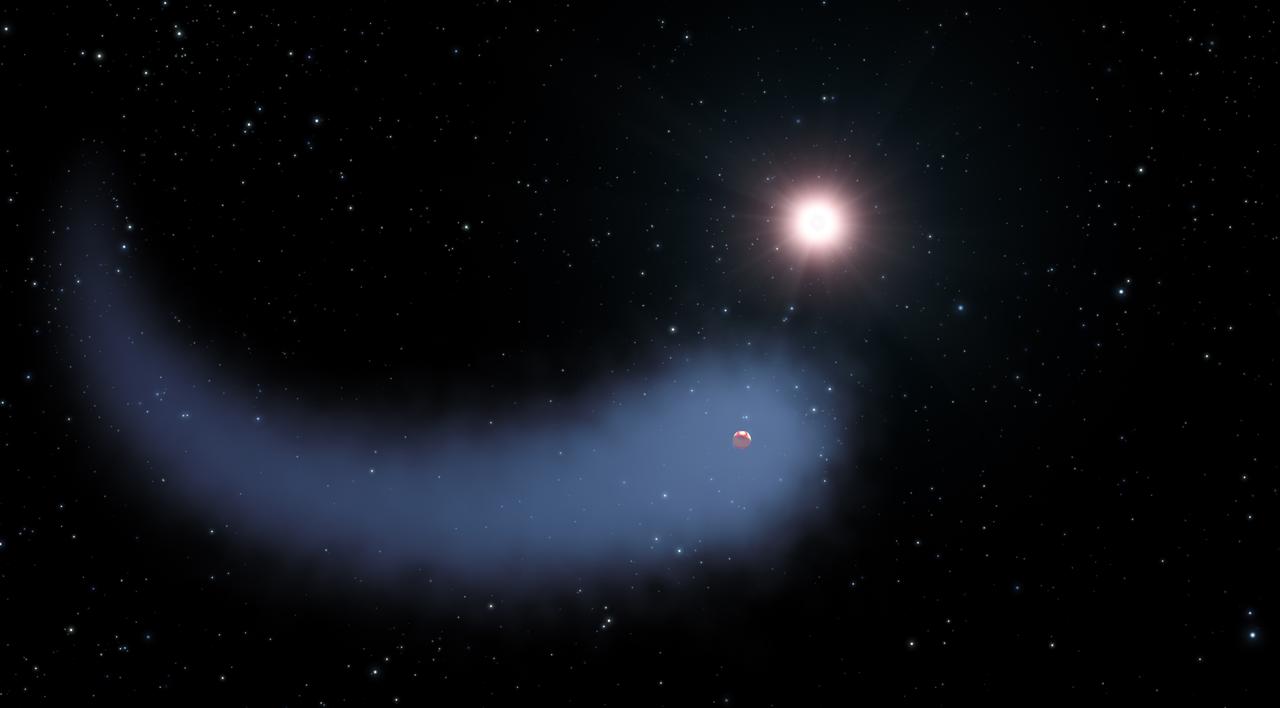Are we alone out there? Many earth-like planets have been described and some of them could certainly harbor life as we know it. Some others, however, may not due to particular atmospheric conditions...
Views 6372
Reading time 4 min
published on Nov 26, 2015
In the past 20 years, scientists have discovered many planets around other stars than the
Sun. Nearly half of these so-called
exoplanets orbit extremely close to their star (more than ten times closer than
Mercury revolves around the Sun in our Solar System), raising many questions about the state of their atmosphere: theoretical studies show that the huge amount of energy that the planets receive from their stars can swell the atmosphere, up to the point where some of its gas is far enough from the planet to escape its gravity and drift away. This phenomenon is called ‘evaporation’.
Because it is light and very abundant, neutral
hydrogen escapes more easily from the atmosphere of an exoplanet than any other element, and can tell us a lot about the properties of high-altitude regions in the atmosphere. Until very recently, evaporation was only known for “
hot Jupiters”, massive giant planets with a mass similar to that of
Jupiter but orbiting very close to their stars. These planets are so massive that although gas escapes from their atmosphere with rates in the order of several thousand tons per second, they only lose a few percent of their mass over their whole lifetime. The evaporating atmosphere appears in form of a hydrogen cloud.
In 2014, J. Kulow and her collaborators published an intriguing signal hinting at the existence of a hydrogen cloud around the “warm Neptune”
GJ436b, a smaller and colder planet than hot Jupiters. At the same time, we were collecting several sets of observations of this planet with the Hubble Space Telescope. After analyzing all the collected data, we found that the transit of the hydrogen cloud starts about two hours before, and ends more than three hours after the transit of the planet. “Transit” is the moment when a planet crosses the disk of its star as seen from Earth. When this occurs, one can measure a small diminution of the stellar light because the planetary disk occults part of the stellar disk. We also found that the cloud is much larger than previously thought, and occults the maximum surface of the star when the planet is at the center of its transit. At this point, the cloud decreases the stellar light by nearly 60 %, far beyond the 0.69 % caused by the planet itself, and about four times higher than for known evaporating hot Jupiters! We inferred from this detection that GJ436b is surrounded by a giant cloud of neutral hydrogen, which trails behind the planet like the tail of a comet.
Using our 3D numerical model of evaporation, EVE (EVaporating Exoplanets), we simulated the structure of this cloud on the computer and compared the results with the actual observations. This way, we found that GJ436b loses between 100 to 1000 tons of neutral hydrogen per second. At first, this appeared surprising because these rates are lower than for hot Jupiters, even though the cloud we observed around GJ436b is larger than any other surrounding hot Jupiters. The difference lies in the fact that GJ436b is orbiting an
M-dwarf (or Red Dwarf) star that is called
GJ436, at about the same distance as evaporating hot Jupiters orbit Sun-like stars. Because M-dwarfs are colder than the Sun, they emit less energy (e.g. heat and light), and GJ436b is much less irradiated (which is why it is called a ‘warm’ Neptune). This irradiation also takes the form of
radiation pressure: when
photons emitted by the star encounter the hydrogen atoms escaping from the planet’s atmosphere, the impact exerts a small pressure on the atoms that repels them away from the star. In the case of hot Jupiters, their very bright stars emit so many photons that radiation pressure is stronger than the gravity of the star and blows the escaping atmosphere away from the planet. Because GJ436 is darker, emitting fewer photons, its smaller radiation pressure cannot blow the gas away. Instead, it brakes its fall toward the star and allows it to diffuse within a large volume around the planet, thus creating the observed giant cloud of hydrogen.
GJ436b, due to its relatively high mass and dark star, will never lose its atmosphere completely; however,exoplanets with lower mass and/or more energetic stars may have evolved more dramatically: if such planets completely evaporated their atmospheres, this could lead to the formation of rocky, atmosphere-less remnants. Some of the exoplanets that are observed today with sizes close to that of the Earth, but very close to their star, could be such remnants. With the American and European surveys of exoplanets, like
TESS and
PLATO, coming in the next decades, we expect to discover many examples of evaporating exoplanets, from moderate cases like GJ436b to planets suffering catastrophic loss of their atmosphere. This will help us to understand the formation and evolution of Earth-like planets.
 Earth & Space
Earth & Space



